Celestial Cells: Advancing Regenerative Heart Therapies in Space
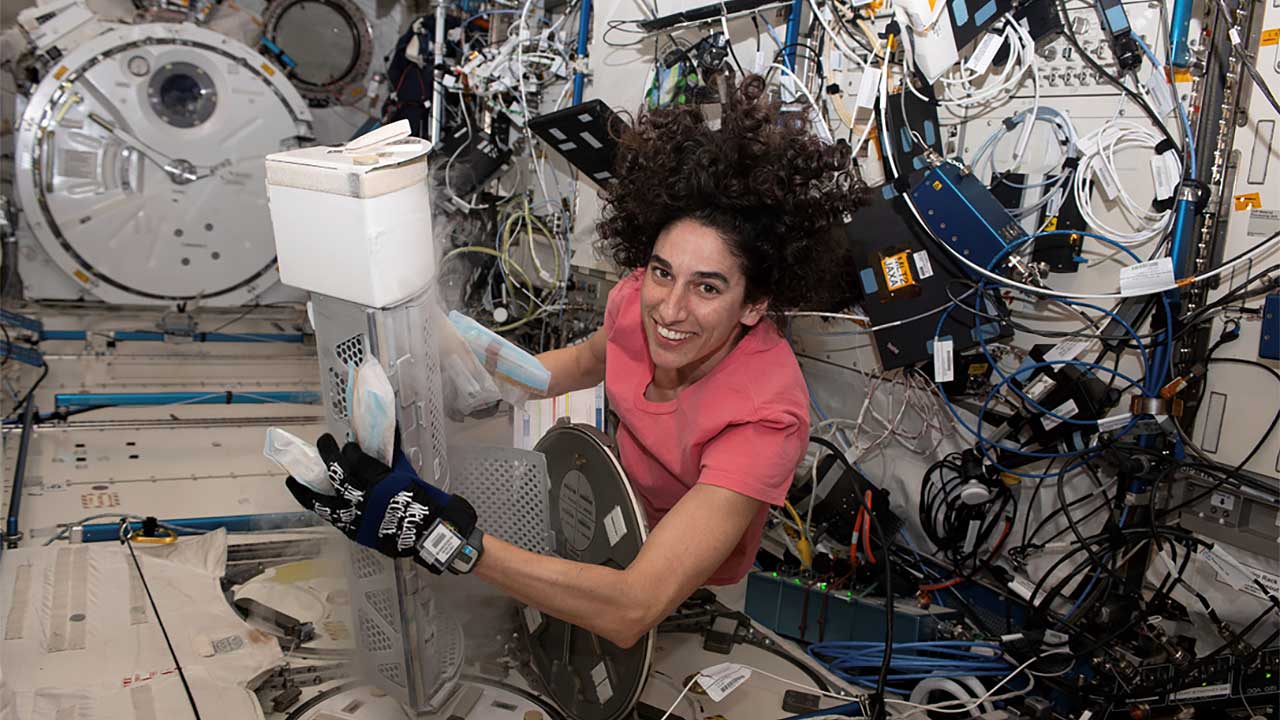
Flight Engineer Jasmin Moghbeli works onboard the ISS in March 2024 to retrieve bags containing heart cells for the Emory team's experiment.
Media Credit: NASA
March 25, 2025 • By Amelia Williamson Smith, Managing Editor
Even the darkest cloud has a silver lining, and the blackest night shines with stars. If you look closely, something good can come out of even the most destructive things.
Consider cancer cells: notorious for their ability to multiply and invade tissues, spreading through the body and wreaking havoc. But what if an observation about cancer cells in space could lead to life-saving treatments for heart failure on Earth?
Scientists have found that cancer cells proliferate—grow and divide to produce more cells—much more quickly in microgravityThe condition of perceived weightlessness created when an object is in free fall, for example when an object is in orbital motion. Microgravity alters many observable phenomena within the physical and life sciences, allowing scientists to study things in ways not possible on Earth. The International Space Station provides access to a persistent microgravity environment.. Spaceflight also triggers cancer cell survival mechanisms, helping the cells better cope with the stressful environment.
Reading about these findings, Chunhui Xu, a professor in the department of pediatrics at Emory University, was struck with an idea. For cancer cells, increased proliferation and cell survival can be deadly. But in Xu’s area of research—the production of cardiac cells to repair heart damage—increased proliferation and cell survival could help save lives. If cardiac cells respond to microgravity in the same way cancer cells do, space-based research could hold the key to accelerating the development of cell-based regenerative therapies for heart disease.
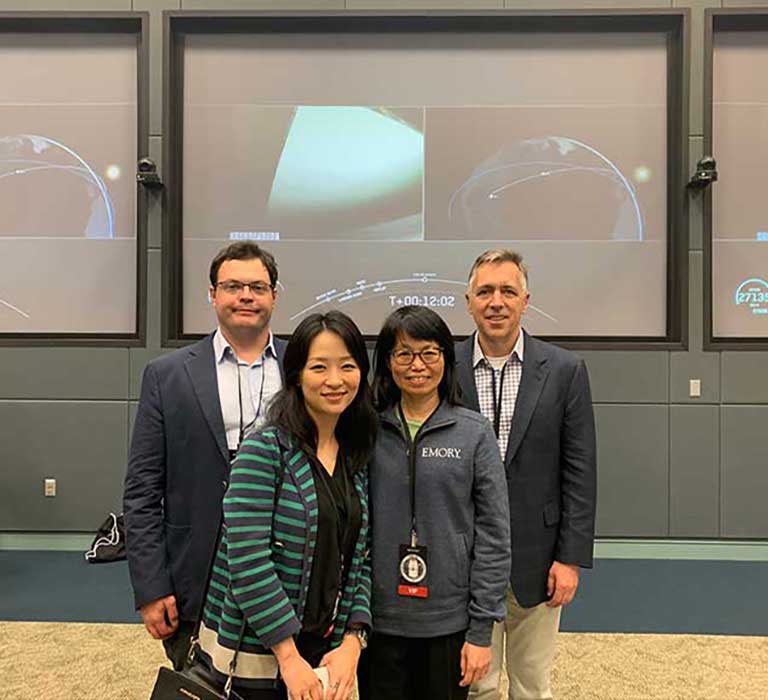
Chunhui Xu (second from right) and her team shortly after their investigation launched to the ISSInternational Space Station on SpaceX CRS-20.
Media Credit: Rich Boling
Xu was one of the earliest investigators to take advantage of research opportunities through the International Space Station (ISS) National Laboratory. Beginning in 2013 with a ground-based experiment using simulated microgravity, Xu and her team began exploring the effects of the space environment on stem cell-derived heart cells.
The team conducted two investigations on the ISS, looking first at stem cells as they differentiate into heart muscle cells and then at heart muscle cells as they mature into tissue-like structures. Findings from these ISS National Lab-sponsored projects led to multiple peer-reviewed publications, including two in the high-impact journal Biomaterials.
“The space environment provides an amazing opportunity for us to study cells in new ways,” Xu said. “Our research on the ISS could allow us to develop a new strategy to generate cardiac cells more efficiently with improved survival when transplanted into damaged heart tissue, which would greatly benefit patients on Earth.”
Healing a Failing Heart
In the United States, one in five deaths is from heart disease, making it our nation’s number one killer. The heart is a powerful muscle that pumps oxygen-rich blood throughout the body, but once heart muscle tissue is damaged, it becomes scarred and cannot regenerate. This makes it difficult for the heart to pump enough blood to meet the body’s requirements. The only option for people with end-stage heart failure is a heart transplant, but the number of people in need of a transplant far outnumbers the donor hearts available.
A Pioneer on Earth and in Space
Xu has been studying stem-cell derived heart cells for a long time. In fact, she is a pioneer in the stem cell field. As a postdoctoral fellow at the Burnham Institute in San Diego, Xu identified a molecule critical for differentiating stem cells into heart cells. She also invented a feeder-free method for culturing human stem cells that is now widely used in the community and is viewed as a milestone in stem cell research. Her publications on stem cells have been cited more than 12,000 times.
“Not everyone can have a donor heart, so the research community has been looking for other ways to save patients by transplanting new heart cells into the damaged area,” Xu said. “This is a very promising field, but there are also challenges.”
One problem is the number of cells needed. Treating a patient’s heart requires about a billion heart cells, which is a lot to generate, so scientists need a way to produce the cells more efficiently.
To generate heart cells, researchers begin by reprogramming blood or skin cells into induced pluripotent stem cells (iPSCs). iPSCs can differentiate into many different types of cells that can then proliferate indefinitely. This makes iPSCs invaluable for producing specific cell types to model diseases, test new drugs, and develop regenerative therapies. For heart therapies, iPSCs are differentiated into cardiac progenitor cells that further differentiate into heart muscle cells, which can be transplanted into patients.
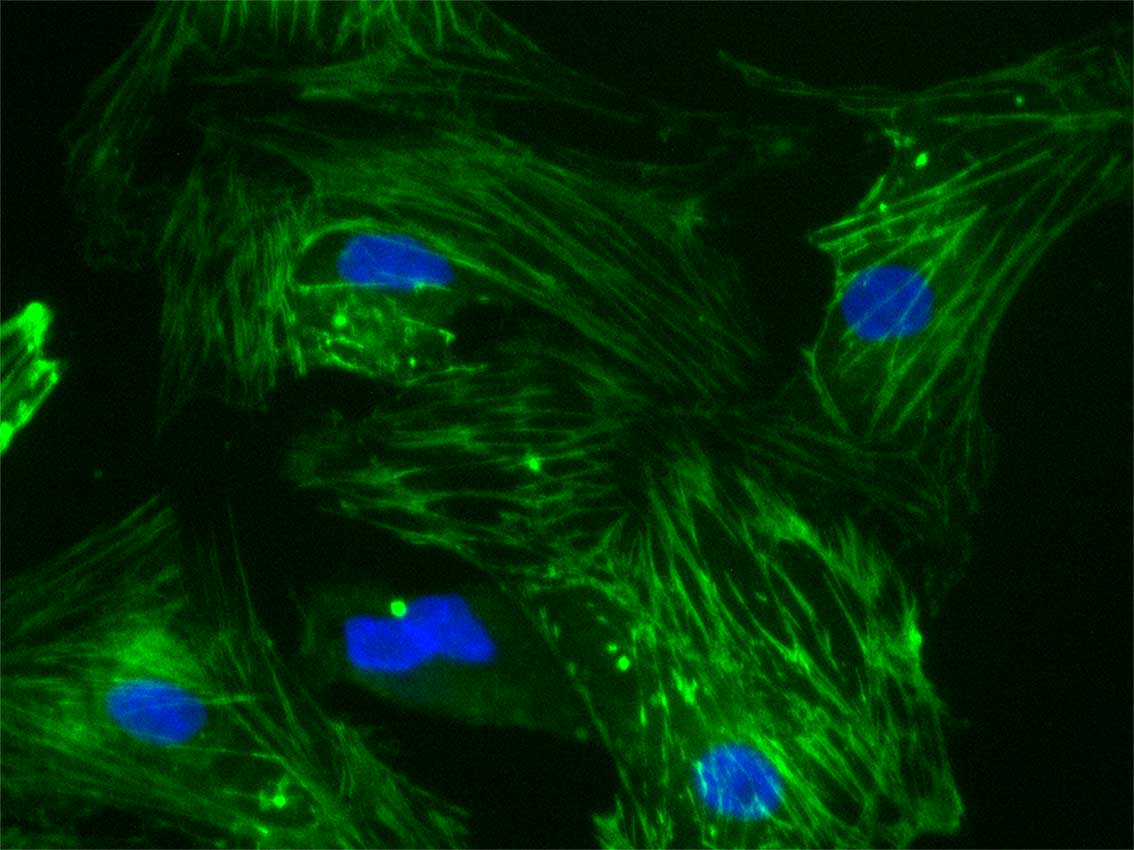
Heart muscle cells stained for muscle proteins (green) and nuclei (blue).
Media Credit: Parvin Forghani, Cardiomyocyte Stem Cell Laboratory
This brings us to another challenge: ensuring the heart muscle cells survive once transplanted. A damaged heart is a stressful environment for cells, which is why there’s a lot of cell loss after transplantation, Xu explained.
“Even if you can generate a lot of cells, if they don’t survive, you still can’t repair the heart,” she said. “So, finding ways to improve cells’ ability to survive is a big step toward making cell replacement therapies a reality.”
Xu believes the key to producing heart cells more efficiently and improving their survivability could lie beyond Earth’s horizon—in space.
Improving Heart Cells With Microgravity
To explore microgravity’s effects on stem cell-derived heart cells, Xu and her team first conducted a ground study using 3D cell growth techniques and simulated microgravity. The experiment revealed that the cells grown in simulated microgravity proliferated much more quickly—at a rate 1.5 times higher than a 3D culture in normal gravity and four times higher than a standard 2D culture.
Finding Space
Xu first learned about microgravity research when the ISS National Lab and NASANational Aeronautics and Space Administration held a Destination Station event at Emory in 2013. ISS National Lab representatives gave a talk at the Emory School of Medicine, and Xu was in the audience.
“If I had missed that seminar, I probably would have never ended up doing space research,” she said. “Before that talk, I knew nothing about space, and it was so exciting to see their presentation about the value of science in microgravity.”
The team also found that heart muscle cells generated in simulated microgravity were purer and more mature than those produced in normal gravity. Both characteristics are critical for cell replacement therapies.
With these encouraging results, the next step was to confirm the findings in actual microgravity. Xu’s first investigation was launched to the space station on SpaceX’s 20th Commercial Resupply Services mission(Abbreviation: CRS mission) A CRS mission is a cargo resupply mission contracted by NASA to deliver supplies and research to the International Space Station on commercial spacecraft as part of the CRS contract with three commercial companies. As part of CRS missions, experiments currently return to Earth on SpaceX Dragon spacecraft that splash down in the ocean. for NASA. For this project, the team worked with ISS National Lab Commercial Service ProviderImplementation Partners that own and operate commercial facilities for the support of research on the ISS or are developing future facilities. Redwire Space Technologies Inc., formerly Techshot Inc. The experiment utilized the company’s Multi-use Variable-gravity Platform (MVP), a facility that uses two centrifuges to provide artificial gravity for research on the space station.

Redwire's Multi-use Variable-gravity Platform (MVP), which uses two centrifuges to provide artificial gravity for research on the ISS.
Media Credit: Redwire Space
Normally, a ground control experiment is done at the same time as a flight project to compare results from microgravity with those from normal Earth gravity (1g). However, with the MVP, scientists can have a 1g control on the ISS alongside the flight experiment, said Rich Boling, a VP at Redwire.
“The MVP’s ability to provide a 1g control in space is important because gravity really is the only difference between the samples,” he said. “They experience the same g-loads during launch and the same atmosphere on the space station—everything is exactly the same between the two experiment groups, and gravity is the only variable.”
The road to space isn’t always easy, and Xu and her team had to overcome several hurdles in preparing the flight project. On the ground, cell culture requires carefully controlled levels of carbon dioxide in the growth medium. However, at the time, the MVP hardware did not support the addition and monitoring of carbon dioxide, so the team had to develop a method to culture cells without it.
Another challenge was finding a way to keep the cells at a very specific stage of development until they reached space. To do this, the team needed to freeze the 3D cell cultures before transporting them to the ISS.
“Freezing 2D cells is a piece of cake—everybody’s doing it, and it’s very routine,” Xu said. “But when you’re dealing with 3D cells, it’s not as easy, so we worked to develop a cryopreservation protocol that allows us to freeze them and have them survive.”
With everything in place, the investigation launched to the space station in March of 2020, right as the COVID-19 pandemic began. “On Earth, everything was shut down,” Xu remembers. “But in space, the astronauts were working on our experiment. Even with everything happening down on Earth, ISS science was still moving on.”
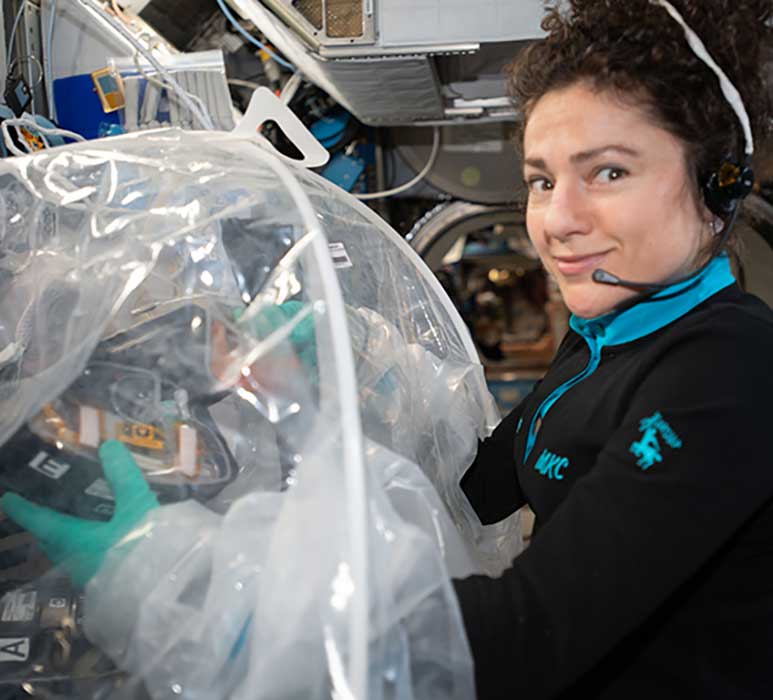
NASA astronaut Jessica Meir working on Xu's first investigation on the ISS.
Media Credit: NASA
The cells remained in space for 22 days, where they matured from cardiac progenitor cells into beating heart muscle cells. When the live cells were returned to Earth, Xu and her team were excited to find the cells had survived the trip, showing that functioning heart muscle cells could be generated in space and successfully returned to Earth.
Upon analysis, the team found several changes in gene expression in the microgravity-cultured cells when compared with the 1g control. Microgravity increased gene expression involved in cardiac cell development and proliferation, confirming the results from simulated microgravity. The team published three peer-reviewed papers on the investigation and then focused on the next step: looking more closely at microgravity’s effects on cardiac cell survival.
Space as a Steppingstone to Regenerative Therapies
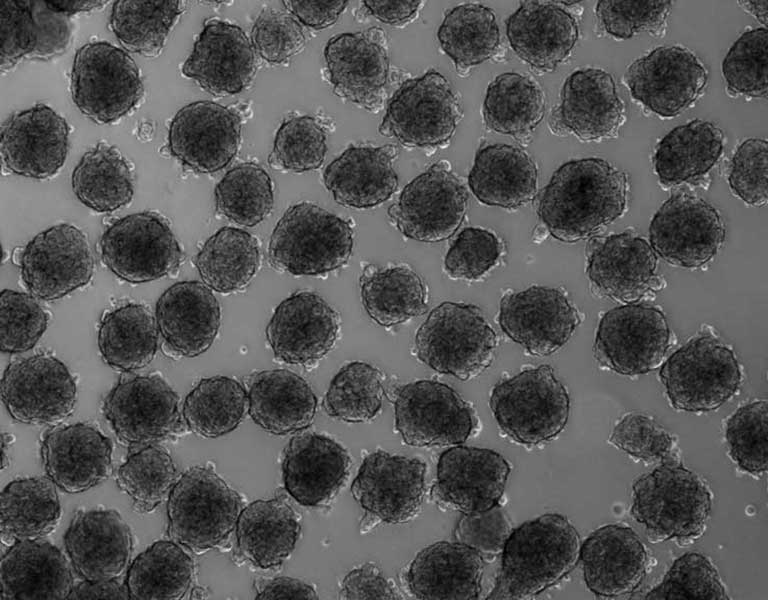
Cardiac microtissues (spheroids) generated from human stem cells using microscale tissue engineering.
Media Credit: Parvin Forghani, Cardiomyocyte Stem Cell Laboratory
Xu’s second flight project examined stem cell-derived heart muscle cells as they matured into cardiac microtissues. These tiny three-dimensional spheroids mimic the structure and function of the human heart.
To culture the cells, the team used BioCell hardware from ISS National Lab Commercial Service Provider BioServe Space Technologies. “We worked with BioSeve to do very intensive testing with the BioCell to make sure the cells would be happy,” Xu said. “We did a lot of testing to prepare for our space experiment because we know it’s such a precious opportunity.”
The team used its cryopreservation method and prepared the cells well before launch. This helped streamline the space experiment and allowed the team to characterize the cells ahead of time. “We wanted to make sure they differentiated nicely into beating cells and that they were the best quality to send to the ISS,” Xu explained.
This time, the control experiment was done on the ground. Xu and her team used the same BioCell hardware and procedures to check and feed the cells that the astronauts used in space. The team even packaged the ground control cells like their spaceflight counterparts and mimicked shipping to eliminate as many variables as possible.
The investigation—Project EAGLE (engineering heart aggregates by leveraging microgravity)—launched on SpaceX’s eighth rotational crew mission (Crew-8) contracted by NASA. While the astronauts worked on the project, the BioServe team, which included a large group of undergraduate students, watched on a live video feed. Because BioServe is a research institute within the University of Colorado Boulder, students play a big role in spaceflight experiments, working on electronics, recording operations, and taking notes, said BioServe research associate Sheila Nielsen.
“During the microscopy, when the astronauts pulled up the cardiac tissues and we could see the cells beating through the microscope, the students were amazed,” she said. “It’s rewarding to mentor students and watch them experience things like that for the first time and see the impact it’s having on them.”
After eight days on the ISS, the microtissues were returned to Earth, and the team was anxious to start the analysis. First, a team of collaborators at Georgia Tech led by Shu Jia performed functional studies, looking at things like cell contraction and calcium signaling. They found that the space-grown microtissues displayed normal heart function.
Xu’s lab then did molecular characterizations and found many differences between the spaceflight microtissues and ground control. Exposure to microgravity led to significant changes in protein levels and gene expression involved in cell stress response, survival, and metabolism.
“Metabolic pathways that we’ve seen in the proliferation and survival of cancer cells were also activated in the cardiac cells in space,” Xu said. “In microgravity, the cells seem to conquer that stressful environment by trying to upregulate their molecular signals for survival, which was quite amazing to see.”
These results, which were recently published in Biomaterials, are valuable because they provide a new avenue that has never been explored to improve the proliferation and survival of iPSC-derived cardiac cells. Insights gained through Xu’s space-based research could lead to significant advances in the Earth-based production of cardiac cells for regenerative therapies to treat heart disease.
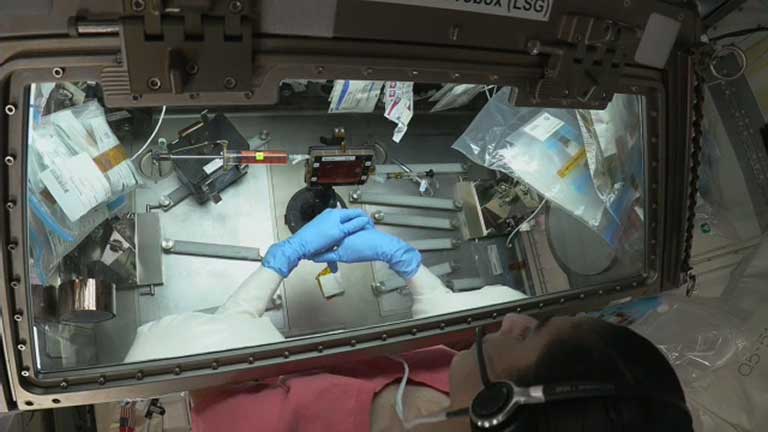
NASA astronaut Jasmin Moghbeli works on the Project Eagle investigation in the Life Science Glovebox on the ISS.
Media Credit: NASA
“Taking cells out of the gravity environment that they’ve evolved to survive in challenges them in a completely different way,” Nielson said. “By seeing how the cells respond, we can learn an enormous amount and apply it to critical health advances on Earth.”
More Answers Raise More Questions
While Xu is excited about the results achieved so far, there are still many questions to explore in future spaceflight studies. “How exactly is mitochondrial function changing? How are the metabolites changing? Additional studies will eventually put the pieces of the puzzle together and give us the details needed to find a new way to produce better heart cells,” she said.
Xu stressed the critical role the ISS National Lab and Commercial Service Providers play in helping researchers like her take their science to space. “You want to lean on their resources and insights—it will help your experiment tremendously,” she said. “They have rich expertise and experience and spend a lot of time working with us to help us understand every small aspect of space research.”

At Kennedy Space Center preparing Project Eagle for launch on Crew-8 (left to right: Sheila Nielsen of BioServe, Chunhui Xu of Emory, John Catechis and Kristin Kopperud of the ISS National Lab, and Parvin Forghani Esfahani of Emory).
Media Credit: Sheila Nielsen
She’s also encouraged by how far science in low Earth orbit(Abbreviation: LEO) The orbit around the Earth that extends up to an altitude of 2,000 km (1,200 miles) from Earth’s surface. The International Space Station’s orbit is in LEO, at an altitude of approximately 250 miles. has come over the last decade. “Conducting research in space is a lot easier now than it was in the early days,” she said, explaining that there’s more expertise, research capabilities and facilities, funding opportunities, and publication of results. There are also more people aware of the benefits of space research.
“Scientists are looking at all aspects of biology to see how microgravity can affect cells, tissues, animals, and disease models—so much can be done in space to help people on Earth,” she said. “By continuing our space research, our goal is to get closer to developing products that could one day reverse heart damage.”